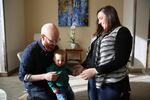
Whitney and Brittany Young play with their son Hazen. Using 'preimplantation genetic diagnosis' they made sure he doesn't carry the family's BRCA gene mutation and its increased risk for cancer.
Kristian Foden-Vencil / OPB
Whitney and Brittany Young met in chemistry class at Northwestern University. They fell in love, moved to Portland in their 20s and got well-paying jobs as software engineers.
As they approached their 30s, they decided it was time to have kids. But Brittany was born without a uterus.
“She went to talk to some doctors and found out that she has great quality eggs,” Whitney Young said, “and that if we were going to have a kid biologically, we would need to use a surrogate in order to have kids and do IVF.”
IVF is in vitro fertilization. It's a procedure in which the eggs are taken out of a woman and fertilized in a laboratory. In this case, instead of placing them back in Brittany, the couple paid a surrogate.
The surrogacy cost about $100,000.
But there was another problem. Whitney Young's family carried the BRCA gene mutation. It significantly increases the risk of breast and ovarian cancers. Whitney's grandmother had breast cancer, and his mother was so worried that she had a double mastectomy.

A family that's paid $20,000 for in vitro firtilization can pay an additional $5,000 to $10,000 to check their embryos for a genetic mutation. Implanting an embryo that doesn't have that mutation, changes the family's genetic line for future generations.
Kristian Foden-Vencil / OPB
“I got tested and found out that I’m a carrier,” he said. “And my sister also found out at some point that she was a carrier. She’s just turned 30 and she’s already had a double mastectomy, so it’s definitely something that we’ve thought about a lot in our family,” Whitney said.
The Youngs talked to a genetic counselor at Oregon Reproductive Medicine, a Portland fertility clinic. The couple learned that for an extra $5,000 to $10,000, their embryos could be checked in a process called "preimplantation genetic diagnosis." The procedure could make sure they picked an embryo that didn't carry the BRCA mutation.
Here’s how it works: Before the fertilized eggs are placed in the surrogate, they’re left to grow in a petri dish for five days. Then, using a laser, the company takes a few cells off the developing placenta of each embryo and checks them for the BRCA gene — or any one of thousands of other gene mutations.
The process can identify embryos that don’t carry a problematic gene mutation, allowing doctors to select those for implanting in the uterus. The resulting baby is at a substantially lower risk of the disease that plagued the family.
"Preimplantation genetic diagnosis" can be used to substantially lower the risk of diseases like sickle cell anemia, fibromyalgia, Huntington’s, muscular atrophy, cystic fibrosis, cardiomyopathy, as well as certain cancers and kidney diseases.

Emily Mounts is a genetic counselor at Oregon Reproductive Medicine, where they can check for thousands of genetic mutations in an embryo.
Kristian Foden-Vencil / OPB
Emily Mounts is a genetic counselor with Oregon Reproductive Medicine. She said that as technology improves, the cost of testing is decreasing rapidly.
"A few years ago, a single genetic test like cystic fibrosis would have been maybe $2,000," she said. "Today, we can do a blood test and test for a few hundred genetic conditions for just a few hundred dollars."
Related: Oregon, The Surrogacy State
Still, the procedure for studying embryos remains expensive. In vitro fertilization costs $20,000, then it’s another $5,000 to $10,000 to check the embryos for a genetic disease.
Mounts said the conditions the procedure is used to treat are often even more costly if the embryos develop.
“It is expensive, but the cost is up-front," she said of the testing.
For now, only wealthy families can typically afford to try rooting out genetic diseases from their bloodlines — which raises questions about who this medicine is benefiting.
There’s also opposition to these kinds of tests for reasons other than cost.
For people who believe life begins at conception, discarding an embryo can be seen as equivalent to discarding a person.
Some ethicists also worry about the moral questions that arise as technology improves and the creation of so-called "designer babies" becomes more realistic. Lawrence Nelson, an associate professor of philosophy at Santa Clara University, said it's way too early to have those kinds of debates.
“This notion that you can pick your child — 'I want a baby that’s going to have blonde hair and be smart enough to go to Stanford’ — we’re a long way from that,” he said. “Right now, people are using this kind of technology to avoid the birth of a child that’s going to be quite seriously burdened by the genetic condition that they would have.”
Brittany Young is one of those people. She said she produced 18 embryos. Several were not viable and several more carried the BRCA mutation.
Brittany originally hoped to have a daughter. But through genetic testing, they discarded most of the female embryos because they possessed the BRCA gene.
“I think I cried when I heard that it is was definitive that it was all boys because it was so shocking," she said. "I think I always wanted a girl. It's hard, but just having the chance to have a baby at all was just such a gift that it was easy to get through that part."
Playing on the floor with their 2-year-old son, Hazen, the Youngs said they did consider adopting, but they wanted a child who was biologically their own.

The embryo that eventually turned into Hazen Young was chosen from about 18 different embryos. Some weren't viable, others were put aside because they carried the BRCA gene mutation.
Kristian Foden-Vencil / OPB
They understand that not everybody is supportive of the process they went through. But, Brittany said, their family seems to be on board now.
“We were definitely nervous about how to explain everything,” she said. “We kind of just decided to be open and explain everything and the why. And I think once we shared the why, people totally understood."
The couple still have two male embryos that don’t carry the BRCA mutation. They’re frozen at Oregon Reproductive Medicine, and the Youngs hope to use them to expand their family soon.
